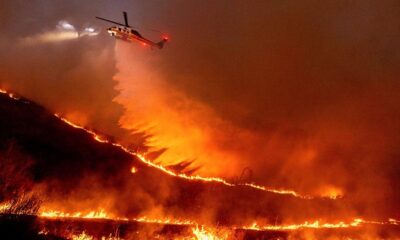Alaska
New quota system to start for trawl harvests of cod in Bering Sea and Aleutians – Alaska Beacon
Commercial fishermen netting Pacific cod from the Bering Sea and Aleutians region will be working under new individual limits starting next year designed to ease pressure on harvests that regulators concluded were too rushed, too dangerous and too prone to accidentally catch untargeted fish species.
The new system will require fishers who harvest cod by trawl – the net gear that scoops up fish swimming near the bottom of the ocean – to be part of designated cooperatives that will then have assigned quota shares. The fisheries service at the National Oceanic and Atmospheric Administration said it has notified eligible participants and is asking for applications.
The cod-trawling program, to start next January, is the first new fishery quota system started since 2012 in federal waters off Alaska, according to NOAA Fisheries.
The Pacific cod harvest is the second-biggest commercial groundfish catch in the waters off Alaska, after pollock, according to NOAA Fisheries. The 2021 commercial harvest totaled 330.4 million pounds and was worth $86.5 million, according to NOAA Fisheries
Pacific cod is harvested by three gear types: longline, which catches fish with hooks arrayed on lines; pot and jig gear, which traps fish; and trawl nets. In the Gulf of Alaska, pot and jig gear dominate the Pacific cod harvest, while longline gear dominates the harvest in the Bering Sea and trawling is the method most used to harvest Pacific cod in the Aleutians, according to NOAA Fisheries.
A quota system has been in effect for several years for longline harvests of Pacific cod, and the total allowed cod catch is already divvied up among the various categories of harvesters through the North Pacific Fishery Management Council process.
While the system to go into effect in January for trawl-caught cod in the Bering Sea and Aleutians is new, numerous other harvests of fish in federal waters off Alaska have previously been converted from open-access systems to quota systems through a process sometimes referred to as “rationalization.”
Through rationalization, maximum catches limits are assigned to specific harvesters through quota shares, replacing systems where participants are allowed to catch as much fish as they can until the season’s limit is reached by the full fleet.
The resulting quota systems are referred to by the North Pacific Fishery Management Council as Limited Access Privilege Programs.
The idea of converting Bering Sea and Aleutian trawl harvests of Pacific cod to this type of system started as early as 2019, when the council was contending with a crash of Pacific cod stocks in the Gulf of Alaska. The council in 2021 recommended creation of the new system. The final rule for it was published on Aug. 8.
Managers concluded that numerous conditions warranted the change, said NOAA Fisheries spokesperson Julie Fair.
“This Program would provide incentives to increase the length of the directed fishing season and allow deliveries to be distributed over a longer timeframe, which would benefit both harvesters and processors,” Fair said by email.
Among the conditions prompting the change are a decline in the total allowable Pacific cod catch and an increase in the number of licensed harvesters and associated vessels, along with “the compressed length of the fishery in recent years, the decreased product quality caused by a race for fish in recent years, need to minimize bycatch, and safety concerns,” she said.
Bycatch is the incidental harvest of untargeted species.
The new quota system is applicable only to trawl harvests of Pacific cod in about the first half of the year, the periods referred to as the A and B seasons. The A season runs from Jan. 20 to April 1 and the B season runs from April 1 to June 10. There is a smaller C season that runs until Nov. 1, but it is not part of the new program.
The new system is supported by trawling industry groups.
The deadline to submit applications for the new quota system is Oct. 10, NOAA Fisheries said.
GET THE MORNING HEADLINES DELIVERED TO YOUR INBOX

Alaska
Flight attendant sacked for twerking on the job: ‘What’s wrong with a little twerk before work’

They deemed the stunt not-safe-for-twerk.
An Alaska Airlines flight attendant who was sacked for twerking on camera has created a GoFundMe to support her while she seeks a new berth.
The crewmember, named Nelle Diala, had filmed the viral booty-shaking TikTok video on the plane while waiting two hours for the captain to arrive, A View From the Wing reported.
She captioned the clip, which also blew up on Instagram, “ghetto bih till i D-I-E, don’t let the uniform fool you.”
Diala was reportedly doing a victory dance to celebrate the end of her new hire probationary period.
Unfortunately, her jubilation was short-lived as Alaska Airlines nipped her employment in the bum just six months into her contract.
The fanny-wagging flight attendant feels that she didn’t do anything wrong.
Diala has since reposted the twerking clip with the new caption: “Can’t even be yourself anymore, without the world being so sensitive. What’s wrong with a little twerk before work, people act like they never did that before.”
The new footage was hashtagged #discriminationisreal.
The disgraced stewardess even set up a GoFundMe page to help support the so-called “wrongfully fired” flight attendant until she can land a new flight attendant gig.
“I never thought a single moment would cost me everything,” wrote the ex-crewmember. “Losing my job was devastating.”
She claimed that the gig had allowed her to meet new people and see the world, among other perks.
While air hostessing was ostensibly a “dream job,” Diala admitted that she used the income to help fund her “blossoming lingerie and dessert businesses,” which she runs under the Instagram handles @cakezncake (which doesn’t appear to have any content?) and @figure8.lingerie.
As of Wednesday morning, the crowdfunding campaign has raised just $182 of its $12,000 goal.
Diala was ripped online for twerking on the job as well as her subsequent GoFundMe efforts.
“You don’t respect the uniform, you don’t respect your job then,” declared one critic on the popular aviation-focused Instagram page The Crew Lounge. “Terms and Conditions apply.”
“‘Support for wrongly fired flight attendant??’” mocked another. “Her GoFund title says it all. She still thinks she was wrongly fired. Girl you weren’t wrongly fired. Go apply for a new job and probably stop twerking in your uniform.”
“The fact that you don’t respect your job is one thing but doing it while in uniform and at work speaks volumes,” scoffed a third. “You’re the brand ambassador and it’s not a good look.”
Alaska
As Alaska sees a spike in Flu cases — another virus is on the rise in the U.S.

FAIRBANKS, Alaska (KTUU) – Alaska has recently seen a rise in both influenza and respiratory syncytial virus, better known as RSV. Amidst the spike in both illnesses, norovirus has also been on the rise in the United States. The Centers for Disease Control and Prevention (CDC) says it’s highly contagious and hand sanitizers don’t work well against it.
Current data for Alaska shows 449 influenza cases and 262 RSV cases for the week of Jan. 4. Influenza predominantly impacts the Kenai area, the Yukon-Kuskokwim Delta, and the Northwest regions of the state. RSV is also seeing significant activity in the Yukon-Kuskokwim Delta and Anchorage.
Both are respiratory viruses that are treatable, but norovirus — which behaves like the stomach flu according to the CDC — is seeing a surge at the national level. It “causes acute gastroenteritis, an inflammation of the stomach or intestines,” as stated on the CDC webpage.
This virus is spread through close contact with infected people and surfaces, particularly food.
“Basically any place that people aggregate in close quarters, they’re going to be especially at risk,” said Dr. Sanjay Gupta, CNN’s Chief Medical Correspondent.
Preventing infection is possible but does require diligence. Just using hand sanitizer “does not work well against norovirus,” according to the CDC. Instead, the CDC advises washing your hands with soap and hot water for at least 20 seconds. When preparing food or cleaning fabrics — the virus “can survive temperatures as high as 145°F,” as stated by the CDC.
According to Dr. Gupta, its proteins make it difficult to kill, leaving many cleaning methods ineffective. To ensure a given product can kill the virus, he advises checking the label to see if it claims it can kill norovirus. Gupta said you can also make your own “by mixing bleach with water, 3/4 of a cup of bleach per gallon of water.”
For fabrics, it’s best to clean with water temperatures set to hot or steam cleaning at 175°F for five minutes.
As for foods, it’s best to throw out any items that might have norovirus. As a protective measure, it’s best to cook oysters and shellfish to a temperature greater than 145°F.
Based on Alaska Department of Health data, reported COVID-19 cases are significantly lower than this time last year.
See a spelling or grammatical error? Report it to web@ktuu.com
Copyright 2025 KTVF. All rights reserved.
Alaska
Sky Watch Alaska: planets align plus the aurora forecast

ANCHORAGE, Alaska (KTUU) – This is a great time of year to do some star gazing. If you have clear skies in your part of Alaska, take the time to check out the night — and morning — sky.
After sunset, look toward the southwest. Saturn and Venus are snuggled up together (of course, they are more than 800 million miles apart) in the evening sky. They set at about 9:40 p.m. in Southcentral.
Before 9:40 p.m., you can see four planets with the naked eye — Saturn, Venus, Jupiter and Mars. Jupiter and Mars stick around through the morning. Mars is very close to the moon right now.
The Aurora forecast is fairly weak for the next few weeks. That’s not to say there won’t be the occasional burst but overall, solar activity is expected to be fairly low until the beginning of February.
If you get great pictures of the planets, the sky, or the aurora, don’t forget to send them to Alaska’s News Source.
See a spelling or grammar error? Report it to web@ktuu.com
Copyright 2025 KTUU. All rights reserved.
-

 Health1 week ago
Health1 week agoOzempic ‘microdosing’ is the new weight-loss trend: Should you try it?
-
/cdn.vox-cdn.com/uploads/chorus_asset/file/25822586/STK169_ZUCKERBERG_MAGA_STKS491_CVIRGINIA_A.jpg)
/cdn.vox-cdn.com/uploads/chorus_asset/file/25822586/STK169_ZUCKERBERG_MAGA_STKS491_CVIRGINIA_A.jpg) Technology6 days ago
Technology6 days agoMeta is highlighting a splintering global approach to online speech
-

 Science4 days ago
Science4 days agoMetro will offer free rides in L.A. through Sunday due to fires
-
/cdn.vox-cdn.com/uploads/chorus_asset/file/25821992/videoframe_720397.png)
/cdn.vox-cdn.com/uploads/chorus_asset/file/25821992/videoframe_720397.png) Technology1 week ago
Technology1 week agoLas Vegas police release ChatGPT logs from the suspect in the Cybertruck explosion
-

 Movie Reviews1 week ago
Movie Reviews1 week ago‘How to Make Millions Before Grandma Dies’ Review: Thai Oscar Entry Is a Disarmingly Sentimental Tear-Jerker
-

 Health1 week ago
Health1 week agoMichael J. Fox honored with Presidential Medal of Freedom for Parkinson’s research efforts
-

 Movie Reviews1 week ago
Movie Reviews1 week agoMovie Review: Millennials try to buy-in or opt-out of the “American Meltdown”
-

 News1 week ago
News1 week agoPhotos: Pacific Palisades Wildfire Engulfs Homes in an L.A. Neighborhood


















